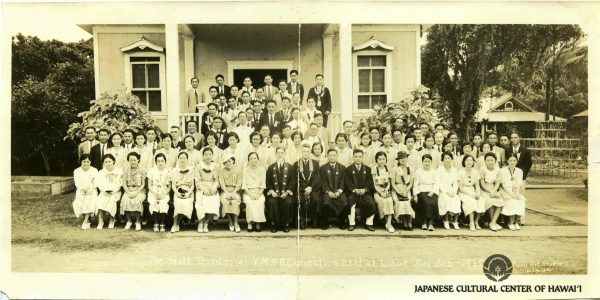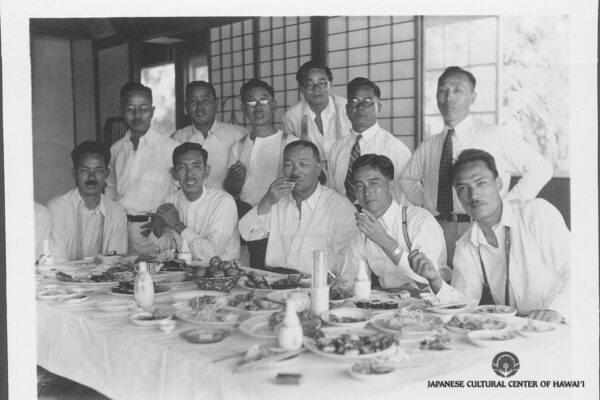Group Media & Photos

Sixth Territorial Young Men's Buddhist Association convention. Lihue, Kauai, August 1935. Rev. Kyojo Naitoh (1st row, 8th from R); Rev. Ryoshin Okano (4th row, center, dark suit); Rev. Kanmo Imamura (5th row, far R, lei, light suit); Rev. Gijo Ozawa (top row, far L). JCCH/Gladys Naitoh Archival Collection.

Buddhist ministers at a restaurant. Front Row (L-R): Chiro Yosemori, Ryuten Kashiwa, Kodo Fujitani, Kanmo Imamura, Ryoshin Okano. Back Row: Konin Matano (3rd), Hakuai Oda (6th). JCCH/Rev. Hakuai Oda Collection.
Internment Locations
Arrested: December 1941
Sand Island Internment Camp, Honolulu, Oahu Island
A group of 172 Hawaii men (mostly Issei) were sent aboard the military transport ship USS U.S. Grant for internment in U.S. Army and Department of Justice camps on the Mainland. Together, the men were sent from camp to camp.
In June 1943, this transfer group was split into two, with this group sent directly from Camp Livingston to the Santa Fe Camp.
From there, some internees were paroled to War Relocation Authority camps, where they were reunited with family members. Others were transferred for repatriation to Japan.
Angel Island Detention Facility, California
March 1942
Camp McCoy Internment Camp, Wisconsin
March 1942 - May 1942
Camp Forrest Internment Camp, Tennessee
May 1942 - June 1942
Camp Livingston Internment Camp, Louisiana
June 1942 - March 1943
Crystal City Family Internment Camp, Texas
March 1943 - September 1943
Exchange Ship M.S. Gripsholm: September 1943
Included among the repatriates who left from New York on the second exchange ship were 72 Hawaii internees and their families.
Singapore
This internee was among a small group of Hawaii repatriates who disembarked at the Japanese-held territory of Singapore.
Repatriated to Japan
In spring 1945, Rev. Ryoshin Okano and son Thomas Ryoju boarded the Japanese hospital ship Awa Maru bound for Japan. At the last minute, the Okanos were removed to make room for Japanese military personnel.
Shortly before midnight, April 1, the Awa Maru was torpedoed and sunk by an American submarine, and more than two thousand passengers and crew were killed, including Hawaii internees Shoichi Asami, his son, Harold Ryozo Asami, and Rev. Jikyo Masaki and his son, Takashi Masaki. Their lives spared, Ryoshin Okano and his son joined the rest of the family and departed Singapore for Japan shortly thereafter.
The Okanos returned to Hawaii in the 1950s.
